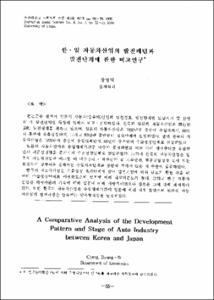보호무역의 경제적 비용과 비관세 장벽에 관한 연구
- Alternative Title
- Costs of Protection and Non-Tariff Barriers
- Abstract
- 최근 선진국들은 개발도상국의 공산품 수입에 대하여 비관세 장벽을 이용한 보호무역을 증가시키고 있다. 이같은 신보호무역의 특징은 가격에 의한 규제 보다는 비가격 조치로의 집중이며, 개발도상국의 주요 수출 산업에 대한 선별적인 운용에 있다. 그리고 GATT 정신에 위배되게 차별적으로 실시하고 있다는 점이다. 또한 보호무역이 세계 경제에 막대한 후생감소를 초래한다는 사실에도 불구하고, 각 선진국들은 자국의 정치적 이해와 산업구조 조정의 지연에 따라 자유무역에 관한 합의를 이루지 못하고 있다.
특히 비관세 장벽 하에 이루어지고 있는 세계 무역의 비율을 보면 선진국의 경우 수입의 약 20%가 비관세 장벽 하에서 이루어지고 있으며, 개발도상국으로 부터의 수입에 대하여는 이보다 더 높은 수준을 나타내고 있다. 따라서 비관세 장벽이 완화 될 경우 개발도상국은 막대한 후생의 증가를 도모할 수 있다. 한국은 1989년 총수출 중 비관세 장벽 하의 수출 비율이 16%를 차지하고 있으며, 선진국 수출 중에서는 22.1%를 차지하고 있다. 또한 한국의 경우는 총수출 중에서 50%를 차지하는 섬유류, 철강제품, 신발류 그리고 전자제품에 집중되어 있다는 사실이. 비관세 장벽이 한국의 수출 전략에 큰 영향을 미치는 요인이 되고 있다.
따라서 앞으로의 다자간 협상이나 쌍무협상에 있어서도 비관세 장벽의 논의는 한국에 있어서 매우 중요하며, 최대의 국가 이익을 위하여 비관세 장벽에 관한 철저한 연구와 대처 방안이 필요하다. 즉 통상마찰을 줄이면서 수출 시장의 다변화와, 규제 하에서는 고부가가치 상품의 수출 개발이 요구 된다.
Recently, a number of industrial countries have introduced or increased protection against manufactures imported from developing countries by imposing non-tariff barriers(NTBs). Striking festures of the new protectionism are the it has used the nonprice measures, focused on the limited sectors and concentrated on supply from Japan and NICs. Also, costs of protection are huge in the world economy. Especially, if non-tariff barriers are removed, developing countries will make gains about 80% of total gains, but developing countries will lose from the tariffs cuts only due to an adverse terms of trade move. Therefore, non-tariff barriers are more important in developing countries than developed countries.
Despite of theses costs, about 34% of industrial countries' imports from developing countries were under import restrictions in 1983 and 21% of industrial countries' manufactures imports were under restrictions. In the case of Korea, 22.1% of Korea exports to industrial countries were restricted in 1989. Among them, Canadian market(23.9%) was the highest and Japan(23.7%), EC(22.3%) and the U.S.(20.1%) followed. According to major exporting commodities, textiles and clothing(35.8%) was restricted the highest under the MFA except cutlery and fish. At this point, we continue to diversify our exporting markets and try to export high-value added products to get more profits under the restrictions.
Recently, a number of industrial countries have introduced or increased protection against manufactures imported from developing countries by imposing non-tariff barriers(NTBs). Striking festures of the new protectionism are the it has used the nonprice measures, focused on the limited sectors and concentrated on supply from Japan and NICs. Also, costs of protection are huge in the world economy. Especially, if non-tariff barriers are removed, developing countries will make gains about 80% of total gains, but developing countries will lose from the tariffs cuts only due to an adverse terms of trade move. Therefore, non-tariff barriers are more important in developing countries than developed countries.
Despite of theses costs, about 34% of industrial countries' imports from developing countries were under import restrictions in 1983 and 21% of industrial countries' manufactures imports were under restrictions. In the case of Korea, 22.1% of Korea exports to industrial countries were restricted in 1989. Among them, Canadian market(23.9%) was the highest and Japan(23.7%), EC(22.3%) and the U.S.(20.1%) followed. According to major exporting commodities, textiles and clothing(35.8%) was restricted the highest under the MFA except cutlery and fish. At this point, we continue to diversify our exporting markets and try to export high-value added products to get more profits under the restrictions.
- Issued Date
- 1991
- Type
- Research Laboratory
- Alternative Author(s)
- Choi, Byong-Cheol
- Publisher
- 사회과학논집
- Language
- kor
- Rights
- 울산대학교 저작물은 저작권에 의해 보호받습니다.
- Citation Volume
- 1
- Citation Number
- 2
- Citation Start Page
- 19
- Citation End Page
- 38
- Appears in Collections:
- Research Laboratory > Journal of social science
- 파일 목록
-
-
Download
 000002025052.pdf
기타 데이터 / 931.89 kB / Adobe PDF
000002025052.pdf
기타 데이터 / 931.89 kB / Adobe PDF
-
Items in Repository are protected by copyright, with all rights reserved, unless otherwise indicated.